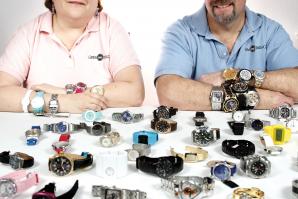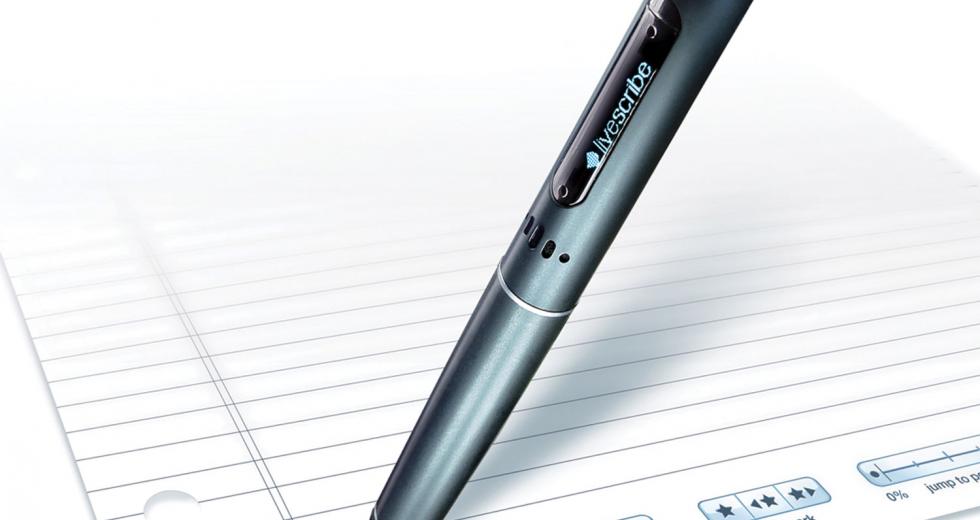In the unqualified realm of science fiction and fantasy, there have been genuine smart gadgets. Take, for example, Bobbi Anderson’s typewriter in Stephen King’s “The Tommyknockers,” which, when alien-enhanced, is able to tap Anderson’s thoughts into pages.
The Livescribe Pulse Smartpen ($169 for the 2 GB version from Target, Best Buy, Costco, Amazon, college bookstores or direct from Livescribe) is far from Anderson’s unholy machine, but its recollection capabilities are the closest we’ve seen in consumer technology so far.
The pen itself almost feels like it’s of alien origin. The slightly chunky piece of anodized aluminum weighs 1.3 ounces, yet it houses an advanced audio recorder, a readout screen and an infrared camera in its tip. These are the essential parts in a device capable of providing a comprehensive audiovisual record of longhand notes taken in a special notebook.
As you write and record, the Pulse Smartpen’s camera captures pen strokes by tracking them against the notebook’s dotted paper, syncing them with the audio it’s grabbing from the microphone. In a meeting, for instance, as you run through action items or make bullet points, the pen notes your change in paper position, earmarks each as a new set of coordinates and links those with the audio. After the meeting, turn the pen to the playback function and touch it to the paper where you’ve written, “Follow up with the client after phase three.” You can hear what was actually said while you were writing the note.
Syncing the pen with your computer using its included cradle and desktop software puts an exact copy of the page on your hard drive and enables you, even without the pen attached, to retrieve that page and what was written (and spoken). Searching your notes is also an option, and despite my horrific penmanship, the program was able to index the words execution, marketing and reinvention from my test notebook. Pencasts, hosted on the Livescribe community site, enable you to upload your technical schematic or chemistry lecture to share with collaborators or the rest of your study group.
The pen’s infrared camera recognizes some preprogrammed shapes, which Livescribe prints at the bottom of each notebook page. Other features include volume and playback speed adjustments.
Livescribe notebooks even contain advanced audio settings to change the microphone sensitivity or audio quality and a scientific and financial calculator, printed into the cover, to tap out complex figures during meetings. There’s also a demo of a translation function, in which you write “hello” on the notepad, select the desired language, tap the word and hear it recited in the chosen tongue.
Since the Smartpen’s launch in January 2008, the note taking-to-audio-to-desktop-to-sharing function is what has made it exceedingly popular with professionals and students relying on accuracy in documentation. However, there are already some users looking to expand the technology’s capabilities, such as West Sacramento resident Steven Holmes.
Holmes is a Java developer who manages the energy grid for Cal ISO and saw a demo of the pen at the 2008 JavaOne Conference. As soon as the demo was over, Holmes and many other attendees, wowed by the pen’s capabilities (its applications are programmed in Java), lined up to buy one. And the tinkering began.
The Pulse Smartpen’s camera captures pen strokes by tracking them against the notebook’s special dot paper, syncing them with the audio it’s grabbing from the microphone.
“It was something I wanted to play with, try doing some stuff with, see what it was good for,” Holmes says. He wanted to try to develop future applications, such as one that would let you use the pen to fill out a form and sync that with a network or one that would help children learn.
Although Holmes has used the pen for its intended purpose, namely taking good notes at training classes, he’s eyeing bigger prospects. “I had the idea that it’d be very useful in a medical situation where you had doctors and nurses running around,” he says. The current system, he continues, is that doctors walk in, sit down at a computer and have their backs to the patient most of the time. However, there could be some use for new technology so they can sit down, look at patients and take notes like they used to, he says.
Other applications are in development by programmers like Holmes, including MyScript, a handwriting recognition plug-in that recognizes what you’ve written and turns it into editable text, interactive datebooks, cross-referenced Bibles, software for the visually impaired and deeper translation tools that can conjugate verbs.
Livescribe has reached out to the programming community, and Holmes was so impressed with the pen that he worked with the Sacramento Java Users Group and Livescribe to get the company to demo the pen to Capital Region Java enthusiasts earlier this year.
“They put a call out, saying they’d like to give presentations to get developers interested in the pen,” Holmes says. The core Sacramento JUG, which numbers around 20, grilled the Livescribe representative about what the pen could do. “The Sacramento group is a no-nonsense group; it’s people who cut through the fluff. We usually sit around and have hardcore technical arguments for about three hours and break off and go get beer and burgers or whatever the case is.”
Although Holmes is, on the whole, very satisfied with the pen, there are features he thinks are integral to its extension beyond note taking. (And, it’s worth noting, the guy who won the giveaway pen at the JUG demo didn’t want it because it’s not compatible with Linux, only PC or Mac.) No. 1 on Holmes’ wish list is cordless syncing. Currently, you have to connect the pen to its USB cradle to transfer data. “It doesn’t have [a wireless] capability now; it’s a synching sort of thing,” he says. “Of course a lot of devices used today need to be synched. But it doesn’t have the capability at this point to do that.”
If an updated model with wireless syncing was unveiled, Holmes says he would replace his current pen. However, he cautions that Livescribe should worry about power issues. Currently the pen’s battery gives around 10 hours of use when fully charged, but wireless capabilities would eat into this time. “It’s literally the one thing, and it may be a huge thing — it could be a real energy sap. … [Wireless sync] would open up a bunch of things; really the obstacle is there’s no way to sync your data. That would open up a million doors. To me there would be almost no limitation at that point.”
Although we found few flaws in the pen for note taking and recalling meetings and conferences, the future of the gadget lies in the ideas and execution of the technical user base, groups such as SacJUG. Livescribe recently announced it’s launching an Application Store to help distribute user-created apps with developers getting a generous 65 percent of the revenue. But even if the community’s big ideas go unrealized, the Livescribe Pulse Smartpen will certainly innovate the way you think about the decidedly ancient practice of jotting notes down.
Recommended For You

Selling Time
An Internet business outgrows a garage and moves to Elk Grove
There’s a married couple in Elk Grove who would be happy to give you the time of day. They’d be even happier to sell it to you.

The Tableted Worker
Is it really possible to leave your laptop behind?
Tablet computers are becoming the tool of choice in multiple industries, adding convenience to simple tasks such as note taking, to more complex operations such as tracking sales. Tablets haven’t replaced laptops yet, but sales trends favor the handheld devices.




